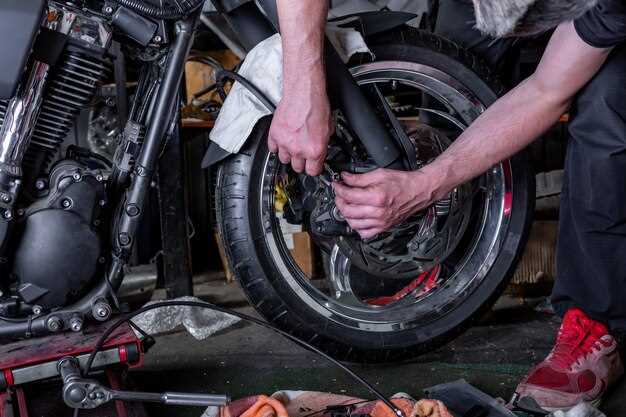
Maintaining your motorcycle tires is crucial not only for enhancing their lifespan but also for ensuring your safety on the road. Tires are the only contact point between your motorcycle and the ground, making their condition paramount. Proper care and regular maintenance can help you avoid premature wear and potentially hazardous situations.
One of the most effective ways to extend the life of your motorcycle tires is through consistent pressure checks. Keeping your tires inflated to the manufacturer’s recommended PSI not only improves performance but also reduces uneven wear. Additionally, monitoring tread depth is essential; once the tread reaches a certain limit, it’s time to replace the tires to maintain optimal grip and handling.
Another key aspect of tire longevity involves proper storage and usage habits. Avoiding excessive sharp turns, rapid acceleration, and heavy braking can minimize strain on your tires. Moreover, storing your motorcycle in a cool, dry place away from direct sunlight can prevent the rubber from degrading, further enhancing its lifespan. By incorporating these practices into your routine, you can ensure that your motorcycle tires remain in excellent condition for many miles ahead.
Proper Tire Pressure: Checking and Adjusting Regularly

Maintaining the correct tire pressure is crucial for safe riding and prolonging the life of your motorcycle tires. Under-inflated or over-inflated tires can lead to uneven wear, reduced traction, and compromised handling. Therefore, regular checks and adjustments are essential as part of your overall maintenance routine.
To begin with, you should check your tire pressure at least once a month and before any long rides. Tires can lose air over time due to temperature changes and natural permeability. Using a reliable tire pressure gauge, measure the pressure when the tires are cold, as this provides the most accurate reading. Refer to the manufacturer’s specifications, typically found on the motorcycle’s frame or in the owner’s manual, to determine the correct pressure.
If you find that the pressure is low, inflate the tires to the recommended level using an air compressor. Conversely, if the pressure exceeds the recommended range, let some air out to achieve the correct level. It’s important to adjust the pressure to suit not only the manufacturer’s recommendations but also the type of riding you plan to do, such as solo rides or carrying a passenger or cargo.
Consistently keeping your tires at the proper pressure not only enhances performance but also improves fuel efficiency and tire longevity. Regular maintenance practices, such as checking and adjusting tire pressure, can make a significant difference in the overall health of your motorcycle tires.
Tread Inspection: Understanding Wear Patterns and Depth
Regular tire care is essential for motorcycle safety and performance. One of the key aspects of tire maintenance involves inspecting tread depth and wear patterns. Proper assessment helps determine when to replace your tires and ensures a smoother ride.
Follow these steps to effectively inspect your motorcycle tires:
- Check Tread Depth:
- Use the “penny test” by inserting a penny into the tread groove. If you can see the top of Lincoln’s head, it’s time to replace the tire.
- A depth gauge can provide a more accurate measurement. Ensure that the tread depth is within the manufacturer’s recommended limits.
- Identify Wear Patterns:
- Center Wear: This indicates over-inflation. Tires lose grip and may wear out faster in the center.
- Edge Wear: Commonly results from under-inflation or aggressive cornering. Check for uneven wear along the tire edges.
- Cup Shaped Wear: This type of wear suggests a misalignment or suspension issue. It often requires professional inspection.
- Flat Spots: A sign of locked brakes or skidding. If present, inspect the brake system and adjust riding techniques.
- Look for Cracks and Bulges:
- Examine the tire sidewalls for any cracks or bulges. These may indicate a weakness in the tire structure.
- Replace tires showing significant damage to prevent blowouts during rides.
Performing regular tread inspections empowers riders to maintain optimal performance and safety. Taking the time to understand wear patterns facilitates informed decisions regarding tire care and replacement, enhancing your overall riding experience.
Storage Practices: Protecting Tires During Off-Season

Proper storage of your motorcycle tires during the off-season can greatly extend their lifespan and maintain optimal performance. To ensure that your tires remain in good condition, follow these essential maintenance practices.
Clean and Inspect: Before storing your tires, clean them thoroughly. Remove debris, dirt, and any potential contaminants, as these can cause deterioration over time. Inspect the tires for cracks, wear, or damage that might compromise their durability. Address any issues before storage.
Keep them Cool and Dry: Store your tires in a cool, dry environment. Excessive heat and humidity can degrade the rubber and alter the characteristics of the tire. Avoid locations with direct sunlight, as UV rays can cause tires to deteriorate more quickly.
Avoid Contact with Chemicals: Ensure that your tires do not come into contact with any chemicals, oils, or solvents. These substances can weaken the rubber compound, leading to premature tire failure. It’s crucial to store the tires away from potential sources of chemical exposure.
Positioning: If possible, store tires vertically (upright) rather than stacking them. This helps prevent deformation of the sidewalls. If you must stack them, rotate the position occasionally to avoid flat spots. For added protection, consider using tire covers to shield them from dust and environmental factors.
Maintain Pressure: Prior to storage, inflate the tires to the recommended pressure level. This helps prevent the formation of flat spots and maintains the integrity of the tire structure. Check the tire pressure periodically throughout the storage period.
Avoid Long-Term Contact with the Ground: If storing for an extended period, place a barrier such as wooden pallets or rubber mats underneath the tires. Direct contact with concrete can absorb moisture and accelerate degradation.
By implementing these storage practices, you will significantly contribute to the longevity of your motorcycle tires, ensuring they are ready for peak performance when the riding season begins again.




